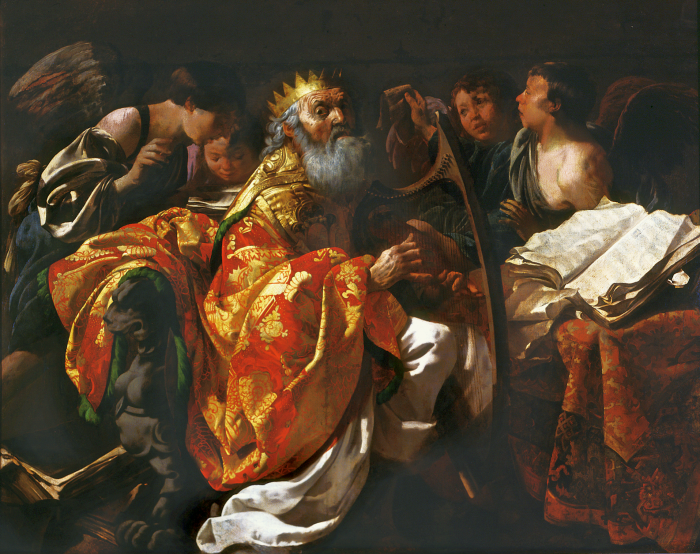
Lesson Objectives
- To begin to appreciate the significance of God’s covenant with David for understanding the content and meaning of the New Testament.
- To understand the biblical idea of the monarchy and the Old Testament background for the Davidic covenant.
- To understand the basic outlines of the promises made to David and the shape of the Davidic kingdom under both David and Solomon.
I. David’s Covenant in Context
A. David and Moses
The drama in the Gospels turns on a single question: Is Jesus the long awaited Messiah, the son of David come to restore the everlasting monarchy promised by God to David?
Underlying this drama - which continues through the Acts of the Apostles and the Epistles and even into the final chapters of Revelation - are centuries of rival interpretations of the Scriptures.
In the Bible and in religious writing outside the Bible, we can see that there were sharply competing expectations about who the Messiah was to be, the "signs" that would accompany his coming, and the shape of the kingdom he would establish.
Through a close reading of the New Testament and key Old Testament passages, we will look at this clash of expectations. We will explore the biblical testimony in context, comparing it with the extra-biblical literature of the period, including the Dead Sea Scrolls and various intratestamental writings. We will see how the proclamation and work of Jesus, as recorded in the New Testament, reflects and reacts to the messianic hopes of his contemporaries.
This study has implications for questions that modern scholars have long debated - How did Jesus understand His mission and work? What were the historical reasons for his condemnation and death on the Cross?
This study also addresses an imbalance in the scholarly and pastoral study of the New Testament. Researchers have tended to focus on the importance and influence of Moses and the covenant at Sinai on the shape of the New Testament. By contrast there has been a relative scholarly neglect of the Davidic covenant.
However, it could be argued that the figure of David and his kingdom is more central - not only to the New Testament - but to the direction and meaning of the Old Testament.
David is generally acknowledged as a defining figure in the Psalms, with more than 70 psalms attributed to him. What is not widely recognized is his prominence throughout the Old Testament.
Indeed, while the name Moses occurs a little over 720 times, David is mentioned almost 1,020 times. David’s career is the subject of 42 chapters, or nearly 30 percent of what scholars call the "Deuteronomistic History" (Joshua-2 Kings).
In the Chronicles, a review of Israel’s history from a "Priestly" perspective, the percentage is the same.
David is mentioned 37 times in the prophets, Moses only seven times. And as we will focus on in our next lesson, the eschatological hopes of the prophets are frequently concerned with the return of a Davidic king and the restoration of his capital, Zion. The prophets say nothing about the return of Moses and a restoration of Sinai.
David’s imprint will be especially felt when we consider key Old Testament concepts and institutions that become central in the New Testament - the Temple, Zion, the “Son of God,” and the “Anointed One” (Messiah).
B. For the Sake of Abraham
We will see, however, that the Law of Moses and the sacrificial system are critical to the understanding and legitimacy of David’s kingdom. But before we can consider the specific character of David’s kingdom, we need to begin with some background.
God’s covenant with David comes as the last in a sequence of covenants found in the Old Testament. These covenants - with Adam, Noah, Abraham, Moses and David - form the narrative structure of the Old Testament.
(For a thorough review of these covenants and their significance, see our on-line class,Covenant Love: An Introduction to the Biblical Worldview).
The background to the covenant with David, and indeed the entire story of Israel, is God’s three-part promise to Abraham - to give him and his descendants their own land, to make them a great and blessed nation, and to make the children of Abraham the source of divine blessing for all the families of the earth (see Genesis 12:1-4).
Each of these promises was "upgraded" to a covenant by God (see Genesis 15; Genesis 17:4-8; 22:15-18).
It was for the sake of this covenant with Abraham that the Israelites were brought out of Egypt (see Exodus 2:24; 6:5). And it was for the sake of this covenant with Abraham that David’s kingdom is established.
In Nathan’s oracle, God repeats three times that He is making this covenant with David for "for My people Israel" (see 2 Samuel 7:8,10,11). This recalls the language God used to explain His actions in liberating Abraham’s children from Egypt (see Exodus 3:7,10;Leviticus 26:12).
Later, in the psalmist’s reflections, the Davidic monarch is seen fulfilling God’s promise to Abraham: "In him shall all the tribes of the earth be blessed, all the nations" (see Psalm 72:17; compare Genesis 12:3; 22:18).
Other Lessons
- Lesson Two: Looking for the ‘New David’
- To understand the basic outline of Israel’s history in the centuries between the collapse of the Davidic kingdom and the beginning of the New Testament era.
- To appreciate how the collapse and disappearance of the Davidic Kingdom shaped Israel’s hopes and beliefs in the five centuries before Christ.
- To understand how God’s covenant promises were interpreted by Israel’s prophets and how those prophecies were understood in the last centuries before Christ.
- Lesson Three: The Son of David in Matthew’s Gospel
- To understand the symbolism Matthew uses to convey the truth that Jesus Christ is the perfect Son of David.
- To see how the baptism of Jesus corresponds to the anointing of the Davidic kings.
- To understand how Matthew sees Jesus’ kingdom as the fulfillment of the promises in the prophets.
- Lesson Four: The Throne of David, His Father
- To see how Luke emphasizes Jesus’ lineage as Son of David in the infancy narrative.
- To see how Jesus appears in public as the Son of David throughout Luke’s Gospel.
- To understand how, at the climax of Luke’s Gospel, Jesus takes his place as heir to the kingdom of David.
- Lesson Five: The Spread of the Kingdom in Acts
- To understand how Jesus’ parting words to His disciples form a map of the ideal Davidic kingdom.
- To see how the structure of the Acts of the Apostles follows that map.
- To see how Luke paints the nascent Church as the Davidic kingdom perfectly restored.
- Lesson Six: ‘The Key of David’: Church and Kingdom in the New Testament
- To understand the characteristics and identity of the kingdom of God as it is portrayed in the New Testament epistles and the Book of Revelation.
- To see how the Church is identified with the kingdom in the New Testament.
- To understand how the Church, as it is portrayed in the New Testament, bears the characteristics of the Davidic kingdom.

